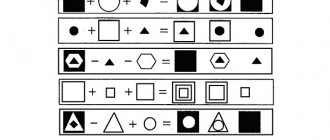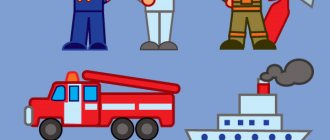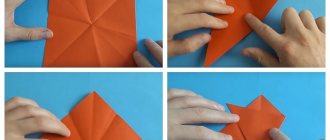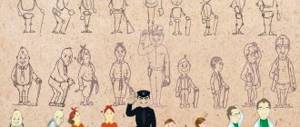Historical reference
Geometry, like other sciences, arose from the needs of practice. The word “geometry” itself is Greek and means “land surveying”. People very early faced the need to measure plots of land. This required certain knowledge and skills. Starting with rectangles and triangles, they gradually began to measure and study the properties of more complex geometric shapes.
From the Egyptian papyri and ancient Babylonian texts that have come down to us, it is clear that already 2 thousand years BC people were able to determine the areas of triangles, rectangles, trapezoids, and approximately calculate the area of a circle. They also knew formulas for determining the volumes of a cube, cylinder, cone, pyramid and truncated pyramid. Information on geometry soon became necessary not only for measuring the earth.
Now geometry is one of the most important branches of mathematics. Of course, she does more than just measure areas. We will include in this section tasks that are in one way or another related to lines on a plane and in space. Geometric knowledge is very necessary for artists and architects, road and spaceship designers. And any person could use a good spatial imagination.
In this lesson we will get acquainted with some geometric shapes and develop a geometric vision of the drawing. Some people have very well developed spatial vision by nature; they can solve geometric problems in their minds, play chess blindly, and navigate the terrain. Not everyone has this from birth. Geometric tasks will help develop such imagination.
Let's start from the very beginning - with geometric objects.
Manuals and materials on the topic
You can cut all geometric shapes for children, their pictures, drawings or coloring pages into separate cards and study them together with your child. They can make a great applique.
All presented flat and three-dimensional figures for preschoolers are multi-colored and bright; any child will enjoy playing with them and learning about them.
Pictures, drawings and coloring pages of geometric shapes for kids are intended for both individual use and for group lessons in early childhood schools and kindergartens.
Activities with cards of geometric shapes develop your child’s horizons and allow you to learn the names and types of various shapes.
Add variety to your children's activities with a variety of geometric shapes flashcard games, e.g.
- you can look for objects similar to these geometric shapes in the house,
- print two versions with geometric shapes, cut one version into cards and attach to the other,
- You can also simply print out geometric shapes for preschoolers, cut them into cards and hang them around the rooms at the child’s eye level. Sometimes approach the cards and unobtrusively name the geometric shapes, and then, when you feel that the child has learned the information, ask him.
Come up with your own variations of the game.
You can download and print geometric shapes in pictures here completely free of charge - click on the image below.
Geometric figures with names in Russian.
Titles in English.
Task: connect geometric shapes of the same shape with a line.
Name and write the names of all geometric shapes.
Connect geometric shapes of the same shape with a line.
Trace the dotted lines.
Count how many geometric shapes
Build a logical chain.
Find all the squares and color them.
Cut the shapes into pieces and name them.
Color it in the appropriate colors.
Circle and name.
Preparatory group. Senior preschool age. Children 6-7 years old
Abstract of GCD for designing “Swans. Journey of the Square" in the preparatory group. Notes on design in the preparatory group "Swans.
Journey of the Square " Construction: Journey of
the Square " Main educational area:
"Artistic and aesthetic development"
.
Goal: Formation of constructive skills when working with origami technique....
Master class on applique from circles “Butterfly” for children 4–6 years old
Theme: "Butterfly"
Master class for children of middle and senior preschool age. Application is modeling on a plane. This type of activity develops children's attention, fine motor skills, perseverance, memory, and imagination; teaches you to finish what you start. Simple jobs can...
Geometric shapes for children of different age groups
If we talk about the little ones, we recommend completing tasks with geometric shapes one unit at a time, since children at this age are restless. The online offer includes a wide variety of card tasks. You can print them out and study at your own time. Studying geometric shapes with children takes place in the form of a game; there is no compulsion or rote learning. For your convenience, you can download the type of task you are interested in.
To make it more interesting for your child to study the types of shapes, the website childdevelop.ru has tasks of different categories: we learn geometric shapes by coloring, we draw by dots, we copy by dots, we trace contours, puzzles, etc.
From early childhood, you need to pay the child’s attention to surrounding household objects:
- cabinet (rectangular);
- plate (round);
- stool (square);
- lamp (oval);
- aquarium (cube);
- bucket (cylinder);
- ironing board (diamond);
- vegetable grater (cone);
- pan lid (pyramid);
- iron (triangular).
How to make Doman cards yourself:
Print the cards on thick paper or cardboard, 2, 4 or 6 pieces per sheet. To conduct classes using the Doman method, the cards are ready, you can show them to your child and say the name of the picture.
Good luck and new discoveries to your baby!
Educational video for children (toddlers and preschoolers) made according to the Doman method “Prodigy from the cradle” - educational cards, educational pictures on various topics from part 1, part 2 of the Doman method, which can be watched for free here or on our Channel Early Childhood Development on YouTube







